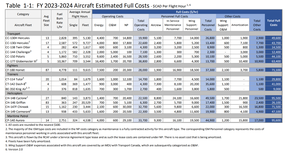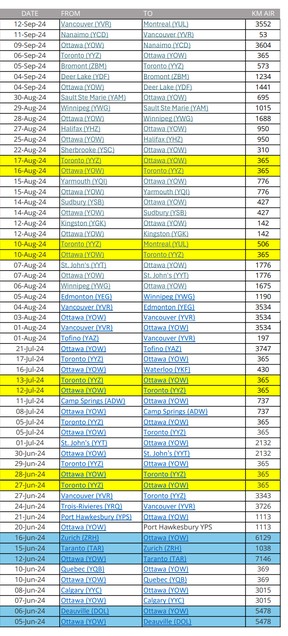According to Ottawa’s own calculations, all this burned fuel caused $200,000 in global environmental damage
Article content
First Reading is a daily newsletter keeping you posted on the travails of Canadian politicos, all curated by the National Post’s own Tristin Hopper. To get an early version sent directly to your inbox, sign up here.
TOP STORY
Last week, Postmedia’s Bryan Passifiume used flight tracker data to calculate the precise number of kilometres that Prime Minister Justin Trudeau logged by private jet over the course of the summer.
Advertisement 2
Article content
He found that between June 1 and Sept. 12, Trudeau logged 92,104 kilometres of jet travel across 58 different trips (scroll to the bottom of this story for a complete table of Passifiume’s findings).
On average, Trudeau was in the air at least once every two days, and his total summer air miles would have been enough to circle the globe twice over. Or, alternatively, those 92,000 km could have been used to take him between Vancouver and St. John’s, Nfld., more than 18 times.
In those three months, Trudeau also logged more air miles than the year’s first seven months put together.
In terms of how much fossil fuel this requires, the best estimate using the Canadian Armed Forces’ own internal cost tables is that Trudeau’s summer schedule required the burning of just under 300,000 litres of fuel.
Trudeau travels in one of two aircraft flown by the RCAF. There’s the CC-144 Challenger, which is essentially a private jet whose commercial model has seating for 12 passengers. And for overseas travel, the prime minister takes an Airbus CC-150 Polaris.
According to the most recent Cost Factors Manual published by the Canadian Armed Forces, the Challenger burns 1,172 litres of fuel for every hour it’s in the air. The Polaris, meanwhile, burns 5,860 litres of fuel per hour.
Article content
Advertisement 3
Article content

All told, Trudeau’s June to September summer travel works out to about 88 hours in the Challenger, and 31 hours in the Polaris, for a total fuel consumption of about 285,000 litres of Jet A-1 fuel.
This is enough to fill up a small city’s worth of Ford F-150s. The truck’s Canadian iterations typically come equipped with a 98-litre gas tank. So, all that jet fuel would fill up around 2,908 trucks.
Alternatively, it would be enough fuel to fill up the swimming pool at a small to mid-sized recreation centre.
And the numbers get even bigger when it comes to the amount of carbon emissions that all these trips produced.
The combustion of 285,000 litres of jet fuel would produce just over 720 tonnes of carbon dioxide, as per tables maintained by the International Air Transport Association.
In just three and a half months, this means that Trudeau’s jet travel emitted enough carbon dioxide to equal the total annual greenhouse gas emissions of 117 Canadians.
The annual per-capita carbon emissions of the average Canadian is 6.15 tonnes – one of the highest rates in the world. And that figure covers everything; not just air travel.
Advertisement 4
Article content
Meanwhile, the government’s own figures estimate that Trudeau’s summer air travel did about $200,000 damage to the planetary climate.
The Government of Canada maintains detailed tables on the “social cost of greenhouse gas emissions.” This is an attempt to break down how much climatological damage is wrought for each tonne of greenhouse gas emissions. The figure (which is cribbed entirely from the U.S. Environmental Protection Agency) covers everything from “agricultural productivity” to “property damage from increased flood.”

For 2024, the “social cost” of a tonne of carbon dioxide was set at $266. So, Trudeau’s 92,000 km of summer air travel imposed an estimated $191,500 in environmental damage, according to his own government.
Climatological damage, incidentally, was the subject of one of Trudeau’s first parliamentary statements after the House of Commons reconvened on Monday for its fall session. “Every Canadian, except perhaps the Canadians in the Conservative Party of Canada, understands that the costs of inaction on climate change will be catastrophic,” he said on Sept. 18, citing “wildfires, droughts, floods and hurricanes.”
Advertisement 5
Article content
It would obviously be unreasonable to expect a Canadian prime minister to govern six time zones without the use of a jet – and this is why even the Green Party is hesitant to begrudge Trudeau’s carbon footprint.
But Trudeau’s jet usage is notable not only because it’s much higher than normal, but because it’s occurred simultaneous with his government actively discouraging travel by others.
Just before the House of Commons broke for summer recess, Health Minister Mark Holland said that road trips were causing the planet to burn. It was a response to a criticism from the Conservative benches alleging that the carbon tax was putting road trips out of reach for some families.
“You can take a summer of fun time vacation where you’re locked in a car for ten consecutive days nonstop with no bathroom breaks … and the cost? Give up the future of the planet … enjoy your ten hours in the car and let the planet burn,” he said.
And just yesterday, the outlet Blacklock’s Reporter published details of a poll by Environment and Climate Change Canada in which they gauged Canadians on their willingness to eschew air travel or at least pay an environmental surtax on airfares.
Advertisement 6
Article content
To the extent that the Prime Minister’s Office is able to plan out travel schedules that minimize fuel consumption, there’s been any number of examples in which that very obviously has not happened.
In 2019, for instance, Trudeau flew from Ottawa to a Florida vacation, only to return to Ottawa for a single day of meetings, and then fly back to complete his Florida vacation. Or there was a time in 2021 when Trudeau flew from Victoria to Montreal for a single budget photo op, and then immediately returned to the West Coast for a vacation in Whistler.
All the while, Canada maintains an official policy of never, ever allowing its first minister to fly commercial – even on the semi-frequent occasion that the prime minister gets stranded in a foreign country when the official jet break down.
The U.K., Germany, Mexico and New Zealand, among others, all put their presidents and prime ministers on commercial flights as often as they can. This is particularly true of domestic travel, which represented almost the entirety of Trudeau’s summertime jet travel.
Nevertheless, the consistent line from the prime minister’s office – whether the PM is Conservative or Liberal – is that commercial travel is prohibited for security reasons.
Advertisement 7
Article content
Recommended from Editorial
IN OTHER NEWS

The Bloc Québécois plan to relentlessly squeeze the Trudeau government on behalf of Quebec is garnering some fierce criticism from the Quebec provincial government. Quebec Premier François Legault (who is also a Quebec nationalist, albeit not a separatist one) said in a press conference this week that he hoped the Bloc would help topple the Trudeau government in order “to defend the interests of Quebecers and the Quebec nation.” Specifically, Legault pointed to the Trudeau government policy of bringing unprecedented numbers of temporary immigrants to Quebec, including scores of refugee claimants who have overwhelmed Quebec shelters.

Get all of these insights and more into your inbox by signing up for the First Reading newsletter here.
Article content



